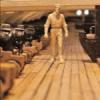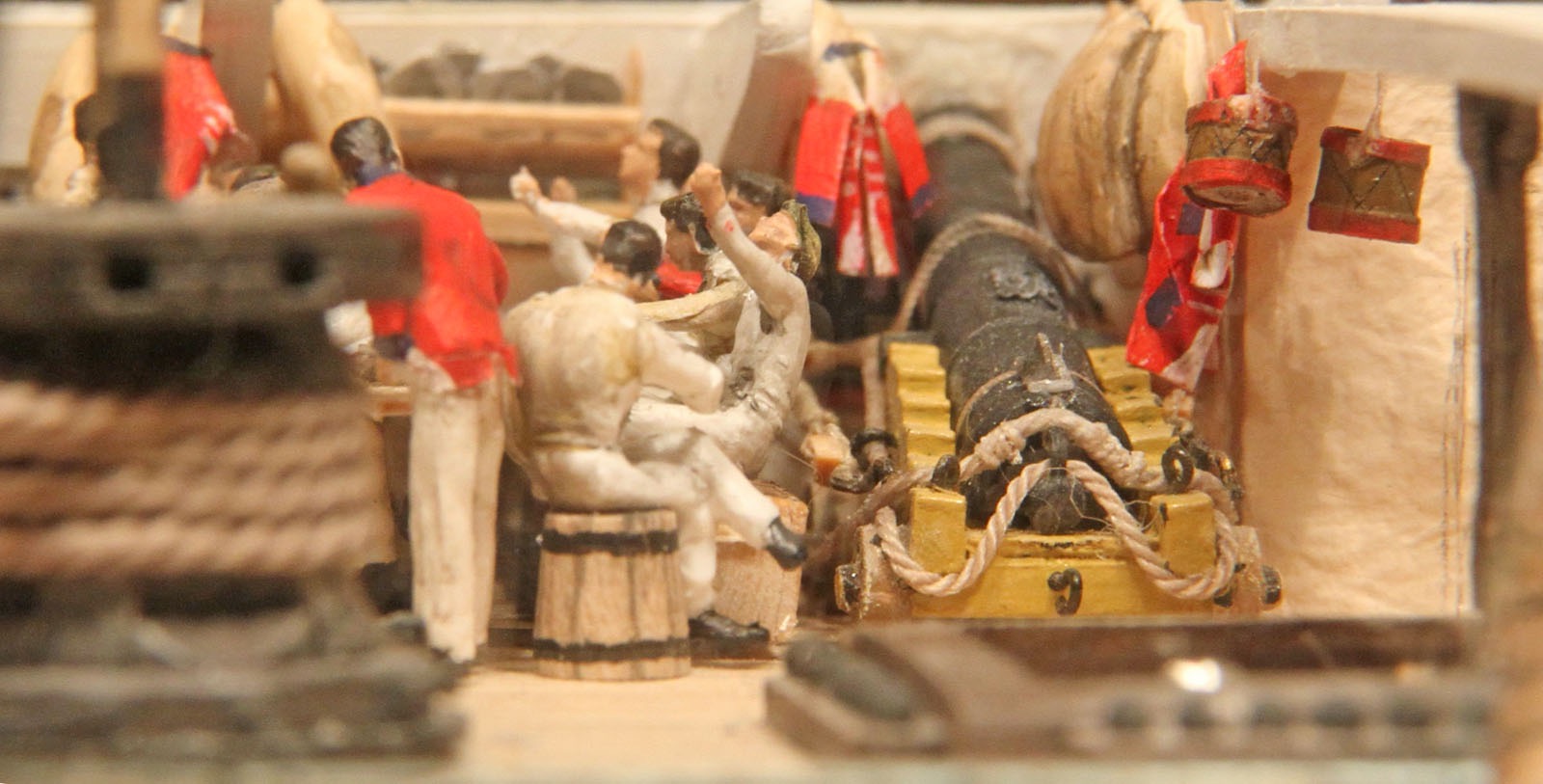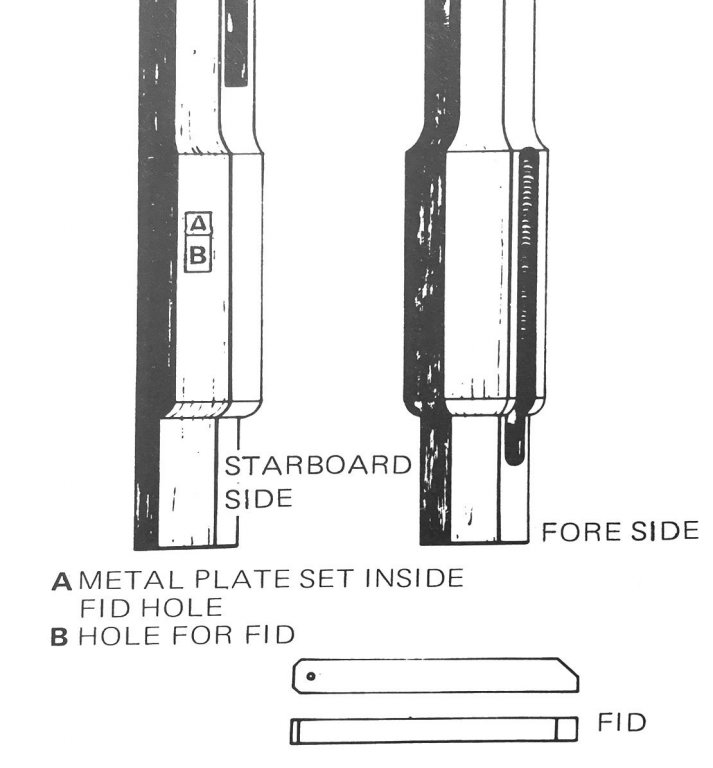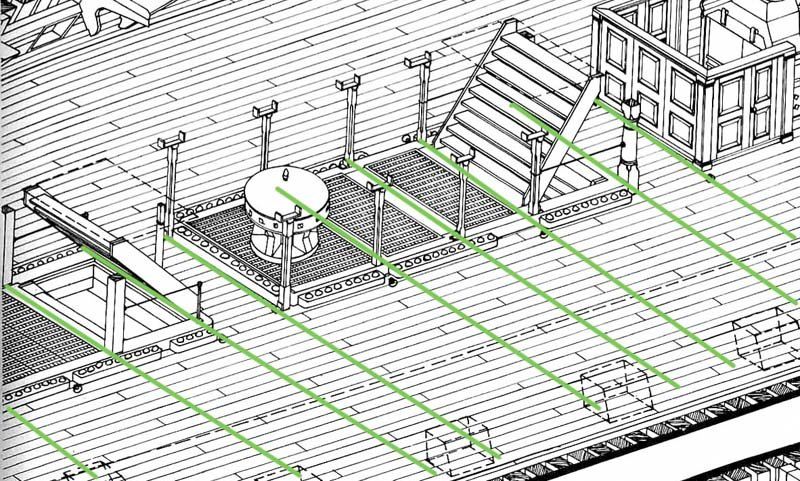-
Posts
2,417 -
Joined
-
Last visited
Content Type
Profiles
Forums
Gallery
Events
Everything posted by dafi
-
Thank you folks! Some more remarks/questions: - Lee writes on page 56, that the top mast pendants were unrove after the mast was topped. Does this mean that before that date the topmast pendants stayed in place? - Lee writes and contemporary drawings show that the port side pendant went through the lower sheave. - According to Lee large ships - like Vic - had tripple blocks lashed to the pendants instead of the usual double blocks. - In the pictures is shown a top made of two halves as by Admiralty order from 1802. (Just a splitline in the middle missing as I saw in my pictures). That is why there is not the usual axial pattern of the rips, but a version according to Lee, Nares and Brady. - the octogonal heel does not necessitate a groove for the pendant as there is enough space to move freely. - the bolsters of the lift blocks on the cap need to be pushed more forward, as they need to be wrapped around the cap and collide with the mast head in this setup. - still to be confirmed the octogonal heeling and the jeer clamps. XXXDan
-
And some end-of bank-holiday-tinkering: blocks mounted, topmast pendants set and the main cap´s round hole padded with leather - what does a modeler´s heart need more?!? XXXDAn
-
Some questions about the masts of British first rates about 1800. - Usually the heel of the topmasts is shown squared, the heeling on the Vic in P. is octagonal, as it is shown in Lee, who states that "Octagonal heeling only on 1St rate ships and by 1773 on all rates" http://files.homepagemodules.de/b564537/f700t5845p131075n2_FzsqAJVt.jpg[/img] Are there any contemporary sources confirming that? And another question arose: The cleat for the jeer block lashing are shown in Portsmouth as a clamp, but most of the literature shows a shoulder piece. What is the correct setup? Was the cleat an earlier or later version? Here both of them together for comparison ... ... and here the shoulder its the right place.
-
Univers played crazy - it concentrated lust, leisure and time in one single small space and as this happened to be my tinkering corner there was no more way to say no ... I was busy for quite a while understanding the real construction of the fighting tops and researching the relating measures in between mast and topmast and so on. Found the Heller parts in acceptable tolerances so made up a plastic dummy to set things straight for a wooden replacement later on. A long missing piece for the puzzle was the small wooden chock, that sets the distance on the lower end of the topmast and defines the distance from the mast head to the topmast. Difficult to spot in the plans, not easy to spot it in the descriptions as it was too easy as a solution ... So I shortened the rubbing paunch to fit in the chock, shortened the bolsters in the front side, detailed the main cap ... ... build in the sheaves, the fid and the iron loop ... ... and also worked the top. Nice to see the chock that sets the distance and the rake of the topmast. The main cap got its splitlines. Another question arose: The cleat for the jeer block lashing are shown in Portsmouth as a clamp, but most of the literature shows a shoulder piece. What is the correct setup? Here both of them together for comparison ... ... and here the shoulder its the right place. Then made he functional tryouts ... ... pushing the topmast through the trestletrees ... ... placed the fid ... ... and fits :-) XXXDAn
-
Best material for small scales :-) Posted February 20, 2013 XXXDAn
-

Statenjacht Utrecht by Angarfather - 1:36
dafi replied to Angarfather's topic in - Build logs for subjects built 1501 - 1750
Wonderfully done! And this is how one works the leeboards - from our forum´s trip to the Netherlands :-) XXXDAn -

I HAVE A COPY OF THE IMAI INSTRUCTIONS FOR 1/100 VICTORY
dafi replied to Bishophobbies's topic in Plastic model kits
Big thank you Paul! Many modelers already asked for them having illegible Heller copies and/or not being able to interpret them. XXXDAn -
As I am "building a piece of plastic" too, I never had that impression. Even more so, my "piece of plastic***" is the fourth most viewed build log on the board, only being surpassed by Dan´s Vulture, Ed´s Young American and B.E.´s Pegasus, what an honor! But one has to have a bit of patience and keep on waving the flag, I unfortunately never realised this build being shown here. Same happens to me, sometimes little or no response, but this happens too if one builds scratch and in wood I believe :-) I even would wish for more pictures! All the best, Daniel *** that is how my wife calls it ...
-
Very tasty result! Never realised that you posted here, thank you, great work! All the best, Daniel
-
Thank God, they were not gruel, oups, cruel or better saying authentic in this sense ;-) But some of the breads hat cabbage on it, for us not to fall ill with scurvy on this long day-trip. XXXDAn
-
And then the most important thing of the day: Food! Food! Glorious food! Then they sat in all the corners possible ... ... and enjoyed themselves quietly ... ... and after a bombastic fennel soup there were still plenty of hearty slices of bread coming ... ... everything freshly prepared on board :-) So we got the power to get some lessons in working the windlass, now we know how it works ... ... tough job but in the end the anchor was finally up. And then the most important: the desert :-) Some sweet slices of Victory, made and presented by confectioner dafi ... ... everyone was allowed to get a taste of it ... ... and was delighted upon the awarded piece! That was a dream getting true: Going to sail with my models :-) How many did have the chance to present their models in such a true surrounding!?! XXXDAn
-
Just realised, I never told you how I got the medal on the last picture of the Utrecht ...hihihihihihihihihi... Not too long ago I was visiting some friends on a modeling exhibition at Fürstenfeldbruck near Munich. I suddenly saw some people disappearing with some great models. I told the guards about the supposed theft and they calmed me down: "Going to the competition" they said. Wanted to see what this means I went there and I saw hundreds of tanks, bi- and triplanes, strip-downs and full-dressed and loads with evil crosses. And then I dicovered one single ship among all those competitors: a wonderfully build RJN Hiryu. Then I saw the medals for the categories, heard the price to take part: 2 (zwei, two, deux, due) Euro and only 1 competitor for the ship´s category? First cheap enough and the second to little competition for my taste ;-) So I ran to the car, got my slice of Victory out - By the deep 17 if one remembers - ran back and 2 (zwei, two, deux, due) minutes before the submission deadline I threw my model onto the table like James Bond his hat in direction Miss Moneypenny. Then some times later the big medal awards ceremony, can you guess what? I made a wonderful second (2, two, deux, due, zwei) Place!!! The other competitor in the category "Ship" only made it to before last. And the only one ahead of me was becoming "Best of Show"! What do we learn from that? - First, dafi never took his medal off again, everybody who saw me evermsince can confirm that! - Those 2 (zwei, two, deux, due, two) Euro were economically well invested - dafi is stupid, for another 2 (zwei, two, deux, due, two) Euro he would have gotten also the bronze medal as he had another slice of Victory still in the car. This is Frank who got a bronze medal with his biplane-strip-down against a competitor field of a felt 723 other planes. So I was better than he was as my beloved medal is SILVER. XXXDAn
-
Born out of a brain fart while joking around in the german forum, a crazy idea became reality and within 12 hours more than 12 people already wanted to take part in it. Soon later we had 20 pirates from all over Germany plus some admiralties in tow that went to the Ijsselmeer, or better to say the Markermeer in the Netherlands. In a well planned and immaculately executed attack we were successfully boarding the beautiful Staatenjacht Utrecht and we found ourselves in the mids of our wildest pirate dreams. And so the scum of several german forums gathered underneath the blood-red-yellow-lioned flag. Foolhardy pirates ... ... applecakesmutjes ... ... in short, the whole landlubbery motley crew was overwhelmed ... ... as the cake was marvelous and more important than the captains speech: "If we sink, do not panic, the water is only approx. 2 meters deep, so be prepared to only get wet feet." But one could see his thoughts: "Oh my god, what have I done to deserve this?!?" Finally on the endless sees of this lake: Putting up sails, everybody had to help ... ... what a delight for a pirate´s soul ... ... then the staysail ... ... and to put up the jib one had even to climb outboard defying deaths and horrors. Look at these professionals at work. The master gave the directions how to coil the ropes ... ... but as usual it ended up in some kind of private bondage lessons. The leeboards had to be put down and up depending on the tack ... ... even the the tiller we were allowed to touch and steer ... ... and - big management mistake - even me they dared to try to cope with steering, so of course the company went a bit off course ... ... but just look, isn´t my silver medal glowing beautifully under this tropical sun ?!? XXXDAn
-
This one I found two weeks ago on the foot of the 7 Provinciens at the Batavia Warft in the Netherlands. Was this an omen that the build was meant to be put on ice?!? XXXDAn
-
Ok, no cat got harmed . I think every scale needs its own technic, as the challenges change. For scale 1:48 thin cloth can work out fine, from smaller than 1:150 paper gets a wonderful choice. My scale of 1:100 is somewhere in-between: The cloth is too coarse or too transparent, on the other hand the sails are too big for paper, also I would like to add some details, that would be difficult in paper alone. In real life I did not have to much time to tinker around due to job and privet commitments, but some small experimenting I could afford. I prepared a small extract of a stay sail, using my laminate technic. I reinforced the leeches by 0,3 mm copper wire The material is that thin, one can see the copper shining through. Took a wet cotton stick and resoftened the sail partially to slowly form a soft wave. The anvil were the handles of a scissors and the hammer was the hot iron. And here the fascinating thing, how the appearance changes with the different moods of light ... ... as originally intended :-) OK, one could guess what comes next ?!? Almost. Another reason for testing to see the limits of the material. And what should I say?!? If one uses hard and pointed tools to make smaller crisps into the material and one slips, the material breaks! But also one can see the benevolence of the material ... ... cleaned and a new leech glued on - this time no copper inside - and it looks like new! And to prove that this invention is really mine, I left a good part of genetic material in the superglue to provide enough DNA-Tests for the future :-) Then formed the hanks for the stay ... ... and tried to fix them, still without leech rope, but still it was quite stable. First trials on the right were not so really shipshape, useful was the third hand of table, clamp and clamping tweezers. And slowly ... ... I was happy. Even though the fixture of the hanks is on the really outer edge, it proves to be very stable. So tried the technic on my small sample and heaved it up. Even though it looks soft, it is quite rigid and keeps well the form due to the white glue used to stiffen it up. Then resoftened with a wet cotton stick partially to get the wave stronger (remember - went bad already once ...) But this time it worked out fine :-) So slept over night - or perhaps not that good as one of the 17 beers that night must have been bad ... ... felt a bit crunched and wrinkled and had the feeling, the sail should exactly represent that. ... fits ... ... XXXDAn
-
Very nicely done the curved planks! Marking the positions of the butts is the best way to do, but be aware, the frames of the kits are usually not in the right positions! You can see on the sketch, that the beams - and therefore the butts - go through the scuttles. Like this the cargo would go not downwards. The position of the beams are always in front and back of the scuttles, or better saying in real life the scuttles follow the beams underneath. [/img] XXXDAn
-
Not too much time to tinker lately due to my working scheme and other private commitments. In the meantime I was already looking for my cat for quite a while. And how do you know, that you found the new daytime hideout of this feline creature? Next modeller´s meeting there will be a lot of chilly con cat ;-) XXXDAn
-
Thank you all for the nice comments. @Richard. Looks like you did not manage to go through the whole report yet ;-) Still further down the page there is more about the copper ... #22 ... and down the road you will find more here ... #53 ... and the most important update here: #1113 ... and some more adventures there: #1203 Actually the Copper is laid over the original Heller structure which surprisingly gets the pattern quite well. Only flaw is the exaggerated height of the overlap. Seen the original thickness and compared to the scale, actually no step should be visible. Even pictures from coppered ship´s bottoms do not reveal the step, only real close ups do show. Next life I will sand the plastic imitations down and will tile the copper flat, the overlap just indicated by a hint of nails. Also there are much more shades of color on weathered copper, telling the story what the ship did last and where it has been, see here: #35 Cheers Daniel
-
Be cautious with the drawings of the planking at McKay´s and McGowan´s books! Both of them show just simplified "mock-"planking, not respecting the beams underneath. One can see butts on the level of then middle of coamings or companion ways. That is NOT correct, those ends would hang in mid air. I marked all possible positions for butts with green lines. All butts in between are incorrect. Only on the green lines there are beams underneath to nail onto. Also note the different distances of the beams, leading to different lengths of the planks. And with the correct spacing of the beams underneath the planks become much longer than shown in this picture. XXXDAn
-
*jumping of joy* Thank you MAurice, it was a great trip to revisit this wonderful build! XXXDAn
- 366 replies
-
- pegasus
- victory models
-
(and 2 more)
Tagged with:
-
Much longer than the 6 meter Mondfeld states :-) As the butts need to respect the deck beams underneath - see their position in AOTS - and with a 3 butt-shift system one gets over 12 meter long planks in the middle of the deck! Also as the deck beams do NOT have the same distances, the length of the planks varies quit a bit! See here the lower deck of my Vic. #68 And if you wnt to be brave, do NOT use straight parallel planks as I did, use the curved ones as this is most possibly more contemporary. XXXDAn
-
Nive build. Love the test-scan for the etch, great for early test-fitting! For the vacuum staircases and other black holes - also gunports - I also use some cotton. Just get a very fluffy quantity into the opening and also dust stays out :-) XXXDAn
- 295 replies
-
- victory
- caldercraft
-
(and 1 more)
Tagged with:
About us
Modelshipworld - Advancing Ship Modeling through Research
SSL Secured
Your security is important for us so this Website is SSL-Secured
NRG Mailing Address
Nautical Research Guild
237 South Lincoln Street
Westmont IL, 60559-1917
Model Ship World ® and the MSW logo are Registered Trademarks, and belong to the Nautical Research Guild (United States Patent and Trademark Office: No. 6,929,264 & No. 6,929,274, registered Dec. 20, 2022)
Helpful Links
About the NRG
If you enjoy building ship models that are historically accurate as well as beautiful, then The Nautical Research Guild (NRG) is just right for you.
The Guild is a non-profit educational organization whose mission is to “Advance Ship Modeling Through Research”. We provide support to our members in their efforts to raise the quality of their model ships.
The Nautical Research Guild has published our world-renowned quarterly magazine, The Nautical Research Journal, since 1955. The pages of the Journal are full of articles by accomplished ship modelers who show you how they create those exquisite details on their models, and by maritime historians who show you the correct details to build. The Journal is available in both print and digital editions. Go to the NRG web site (www.thenrg.org) to download a complimentary digital copy of the Journal. The NRG also publishes plan sets, books and compilations of back issues of the Journal and the former Ships in Scale and Model Ship Builder magazines.




